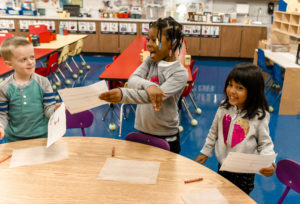Results of the 2019 report from the NAEP on nationwide student performance showed that reading scores for 4th graders were lower than the previous performance assessment in 2017, with 38% of students in this grade reading at a “below basic” level. Statistics like these have prompted the International Dyslexia Association and other advocates of reading intervention to take a closer look at what defines effective instruction.
Structured Literacy is an approach that provides a framework to include both the principles (how we should teach) and the elements (what we should teach).
How to Teach Structured Literacy
Teachers need to have a solid understanding of the principles of Structured Literacy.
Explicit
During explicit instruction, the teacher gives a direct and clear explanation for each new concept. Instruction should be enhanced with multi-sensory strategies to involve the visual, auditory, and tactile/kinesthetic senses in learning to enhance memory.
Introduction is followed by modeling and student application of the new concept. While the student is applying the new knowledge, the teacher provides guidance and specific feedback to promote errorless learning.
Systematic
The delivery of instruction follows a well-defined scope and sequence, which provides a logical progression of skills that move from simple to more complex.
Cumulative
Newly introduced concepts are layered upon previously learned concepts. The foundation of knowledge for phoneme-grapheme relationships, reliable spelling patterns, and generalization of rules is frequently reviewed to build automaticity.
Diagnostic/Responsive
Continuous formative assessment informs progress monitoring and allows for teachers to make decisions for prescriptive teaching and differentiation.
When we look at the elements of Structured Literacy, Gough and Tunmer’s Simple View of Reading can provide a snapshot of the two processes that are required for the student to achieve reading comprehension: decoding (word recognition) X language comprehension = reading comprehension.
Dr. Hollis Scarborough’s well-referenced Reading Rope provides a research-based analogy that takes these two processes and breaks them down into sub-processes and skills. These are woven together to give a clear representation of how these decoding skills and comprehension strategies are intertwined to lead to skilled reading.
What to Teach to Support Decoding
Phonemic Awareness
In 2000, the NICHD reported that over 90% of students who presented with significant reading problems exhibited a core deficit in their ability to process phonological information. This was particularly evident at the phoneme level and identified phonemic awareness skills as a reliable predictor of future literacy learning. In preschool, teachers should expose students to oral exercises or listening activities, that will enhance awareness of the smallest parts of our spoken language, such as sounds and syllables. As they develop skills to hear and identify the parts, they can then progress through more advanced activities to strengthen an ability to manipulate sounds and syllables accurately and automatically.
In preschool, teachers should expose students to oral exercises or listening activities, that will enhance awareness of the smallest parts of our spoken language, such as sounds and syllables. As they develop skills to hear and identify the parts, they can then progress through more advanced activities to strengthen an ability to manipulate sounds and syllables accurately and automatically.
Phonics
Students should receive explicit instruction in recognizing the sound-symbol correspondence. As students are taught that graphemes (letters) and letter combinations represent phonemes (sounds), they can progress to blending these sounds to sequentially move from the sound to syllable to multi-syllabic word level in decoding.
Orthography
The English language is made up of a complex structure of 26 letters that are represented by 44 sounds. Students benefit from cumulative instruction that focuses on building letter and word patterns into memory to enhance spelling knowledge. Structured Literacy teaches the student to identify syllable patterns and types to provide a strategy to break multi-syllabic words into syllable for easier decoding.
Morphology
Morphemes encompass the meaningful parts of words and are often recognized as prefixes, suffixes, roots, and combining forms. Morphological awareness begins early in the young child’s use of language and later provides a strategy for word-level reading, spelling, and vocabulary. The explicit, systematic, and sequential instruction of morphological knowledge will also prepare students to transition into third grade, where Latin and Greek-based roots are commonly presented in text.
What to Teach to Support Language Comprehension
Syntax
A student’s understanding of the parts of speech is also predictive of reading comprehension. Across the grades, the structure of sentences becomes more complex students can easily get lost if unable to recognize concepts such as pronoun referencing, use of connective words, agreements, clauses, and more.
Semantics
Teachers must continue to advance their students’ vocabulary development with repeated exposure to Tier 2 words, and more sophisticated language used in teacher-read text. In addition, students will benefit from learning strategies to enhance word meaning including the use of context clues, application of synonyms, lessons in figurative language, and visualization.
Discourse
A student’s background knowledge can significantly impact his overall comprehension. Comprehension will profit when teachers model metacognition during reading. When modeled consistently, skills such as predicting, questioning, inferencing, clarifying, and summarizing will enhance student engagement with the text. Teachers should weave opportunities to focus on cause/effect, compare/contrast, and various text structures.
The Institute for Multisensory Education has been training teachers for over 25 years. If you are looking to enhance your professional knowledge and share the gift of Structured Literacy in your classroom, contact info@imse.com to learn more about opportunities for training and support.
Be sure to check out the rest of our blog series on Structured Literacy vs. Balanced Literacy:
- What Is Structured Literacy? Part 1 of Structured Literacy vs. Balanced Literacy
- What Is Balanced Literacy? Part 2 of Structured Literacy vs. Balanced Literacy
- Why Teach Structured Literacy Part 3 of Structured Literacy vs. Balanced Literacy
About The Author
 Dr. Kirstina Ordetx is a Level 4 Master Instructor with The Institute for Multi-Sensory Education (IMSE). She holds a doctorate in Counseling Psychology with a concentration in pediatric neurology. Dr. Ordetx is an educational specialist with over 25 years of clinical experience, research, and consultation. She is a certified Structured Literacy Dyslexia Interventionist through the Center for Effective Reading Instruction, a Certified Nutrition and Wellness Consultant, Executive Functions Coach, and a registered Licensed Mental Health Intern. Dr. Ordetx has published two books that compile her research and practice in Theory of Mind. She has served on accreditation committees for the Florida Council of Independent Schools, is a university adjunct professor in developmental and child psychology, and presents at various national and international conferences. Dr. Ordetx is head of school for a private academy in Lakewood Ranch, Florida specializing in the multi-sensory education of students who have language and learning-based differences. She is the Executive Director of the Pinnacle Pediatric Therapy Group, a multi-disciplinary, pediatric therapy clinic.
Dr. Kirstina Ordetx is a Level 4 Master Instructor with The Institute for Multi-Sensory Education (IMSE). She holds a doctorate in Counseling Psychology with a concentration in pediatric neurology. Dr. Ordetx is an educational specialist with over 25 years of clinical experience, research, and consultation. She is a certified Structured Literacy Dyslexia Interventionist through the Center for Effective Reading Instruction, a Certified Nutrition and Wellness Consultant, Executive Functions Coach, and a registered Licensed Mental Health Intern. Dr. Ordetx has published two books that compile her research and practice in Theory of Mind. She has served on accreditation committees for the Florida Council of Independent Schools, is a university adjunct professor in developmental and child psychology, and presents at various national and international conferences. Dr. Ordetx is head of school for a private academy in Lakewood Ranch, Florida specializing in the multi-sensory education of students who have language and learning-based differences. She is the Executive Director of the Pinnacle Pediatric Therapy Group, a multi-disciplinary, pediatric therapy clinic.
